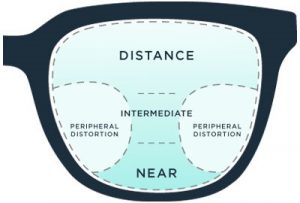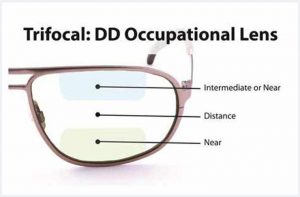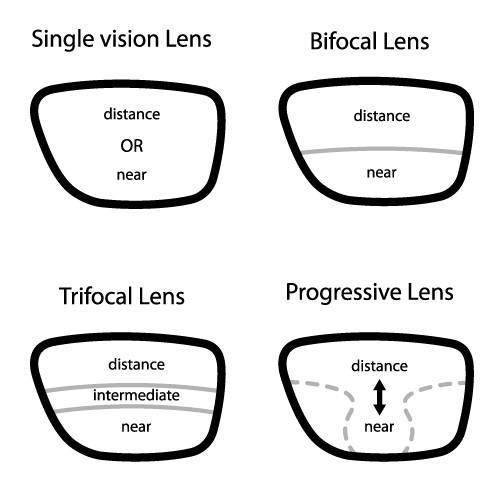Choosing your lens technology may seem like a simple endeavor but we still have a lot of options to go over!
Depending on your age, your eyes or your task at hand may determine which lens option would be best for you to use. You may find that one pair is just not enough for all the tasks you are needing to do! Lets take a look at some of the most usual options, shall we?
Single Vision Lenses
Single vision lenses are exactly what they sound like, they are made to one single focal point of vision and the prescription used will be based off of your eye shape and the length of distance that is needed. For example, a pair of reading glasses are set to about 14 inches from the eyes, where as a single vision distance lens would be based off of your prescription looking more like 10 ft or more away. A single vision lens can be customized to any particular distance needed, and is a very easy lens to use since the prescription is the same all the way throughout the lens. However, for many people, this one focal point is not enough for multi-tasking and convenience sake. Using Single Vision lenses, the patient would need a different pair of lenses for every task distance they are using - and this can get very annoying to be constantly switching your glasses on and off throughout the day.
Therapeutic, Anti-Fatigue, or Boost lenses
This lens style has a few different names, depending on what your clinic prefers, but the therapeutic lenses, anti-fatigue lenses and Boost lenses are essentially all the same thing. This is not a standard progressive lens, but does involve some of the progressive technology in its design. Essentially, we can also call it a "Baby Progressive Lens". This is a SV distance lens that has a very small amount of extra reading power in the bottom of the lens. You may find that when wearing these lenses, you notice a slight aberration or distortion in the very edges of your peripheral vision, and this is not unusual. Fortunately, your brain will totally ignore this portion of the lens once you have allowed yourself time to adapt to the technology. This style of lens is great for anyone who is not yet requiring a full add reading power, but is already starting to feel the signs of eye strain when reading or using a computer or device like a tablet. This style of lens is also great for someone who may have a slight imbalance in the eye muscles, as the added power in the bottom of the lens will help to relax the muscles more making it easier for the eyes to converge in a near vision way. Because these are not a full progressive lens, the boosted power will likely only go so high - so you may find that your prescribed powers may be outside of the parameters for this type of lens.
lenses are essentially all the same thing. This is not a standard progressive lens, but does involve some of the progressive technology in its design. Essentially, we can also call it a "Baby Progressive Lens". This is a SV distance lens that has a very small amount of extra reading power in the bottom of the lens. You may find that when wearing these lenses, you notice a slight aberration or distortion in the very edges of your peripheral vision, and this is not unusual. Fortunately, your brain will totally ignore this portion of the lens once you have allowed yourself time to adapt to the technology. This style of lens is great for anyone who is not yet requiring a full add reading power, but is already starting to feel the signs of eye strain when reading or using a computer or device like a tablet. This style of lens is also great for someone who may have a slight imbalance in the eye muscles, as the added power in the bottom of the lens will help to relax the muscles more making it easier for the eyes to converge in a near vision way. Because these are not a full progressive lens, the boosted power will likely only go so high - so you may find that your prescribed powers may be outside of the parameters for this type of lens.
Progressive lenses
Most people are pretty familiar with the progressive lens options now a days, as it is a very convenient option to cover most of your visual needs in one lens. These lenses will be significantly more than a single vision lens would be, but that is because the Progressive will have 3 different focal points you can use: Distance, Intermediate and Near. Progressive lenses are geared to give you optimum distance vision while  still having the ability to see in an intermediate or a near range. This means we have 3 focal points that blend from one power to the next, giving you a seamless switch from one power distance to another. One progressive lens will not be the same as another however - there are hundreds of progressive lens designs on the market including old designs from 20-30 years ago, depending on where you purchase them. Most quality clinics will only offer a selection of the newest lens options, but it is best to be wary when getting a very inexpensive progressive lens - this could be an indication that it is old technology that is harder to adapt to. Progressive lenses tend to be a bit like computers, in the way that the advancements and technologies involved in them seem to improve faster and faster over the years! This is great to consider, because even if you once tried progressive lenses years and years ago and hated them, you may find they have improved enough for you to find some use in them. The one thing to consider with a progressive lens is you may find it is not ideal for long term reading or computer use, as the visual corridor can be more limiting for those longer timeframe tasks. However, glancing down to read something quickly, or a quick glance at a computer screen for information should be easy and convenient for the wearer. This is likely going to depend on the lens you choose and the strength of your prescription, as newer and higher technology lenses will give you more usability in the lens over all, but a strong prescription may narrow the usability of the lens for you.
still having the ability to see in an intermediate or a near range. This means we have 3 focal points that blend from one power to the next, giving you a seamless switch from one power distance to another. One progressive lens will not be the same as another however - there are hundreds of progressive lens designs on the market including old designs from 20-30 years ago, depending on where you purchase them. Most quality clinics will only offer a selection of the newest lens options, but it is best to be wary when getting a very inexpensive progressive lens - this could be an indication that it is old technology that is harder to adapt to. Progressive lenses tend to be a bit like computers, in the way that the advancements and technologies involved in them seem to improve faster and faster over the years! This is great to consider, because even if you once tried progressive lenses years and years ago and hated them, you may find they have improved enough for you to find some use in them. The one thing to consider with a progressive lens is you may find it is not ideal for long term reading or computer use, as the visual corridor can be more limiting for those longer timeframe tasks. However, glancing down to read something quickly, or a quick glance at a computer screen for information should be easy and convenient for the wearer. This is likely going to depend on the lens you choose and the strength of your prescription, as newer and higher technology lenses will give you more usability in the lens over all, but a strong prescription may narrow the usability of the lens for you.
Bifocal/Trifocals
Yes, these are still a thing! Bifocals were invented in the year 1785 by Benjamin Franklin, but we are still using them today! Even with the advancements in multifocal lenses, some brains just don't like to get used to the newer technology lenses, and want to stick in an older style product they are already used to like a bifocal or a trifocal lens. These lenses are the standard "grandpa style" lens where you have your distance in the top portion of the lens, and then you have a visible segment in the bottom for the Bifocal or Trifocal powers to be in. These lenses are not necessarily the best adaption for the brain, as it can be more difficult to get used to the image jump you may notice in the segments of the lens when not looking through your distance, so if you are a first time multifocal wearer and you aren't sure what to choose, I'd always recommend starting with the Progressive first, as it has a much more natural flow from one power to the next. However, this is just not an option for some people, and that is ok. You will find that a bifocal lens is much more limited in its options and customizations, because it is a very old technology, but that doesn't mean it is any less effective for it's wearer.
advancements in multifocal lenses, some brains just don't like to get used to the newer technology lenses, and want to stick in an older style product they are already used to like a bifocal or a trifocal lens. These lenses are the standard "grandpa style" lens where you have your distance in the top portion of the lens, and then you have a visible segment in the bottom for the Bifocal or Trifocal powers to be in. These lenses are not necessarily the best adaption for the brain, as it can be more difficult to get used to the image jump you may notice in the segments of the lens when not looking through your distance, so if you are a first time multifocal wearer and you aren't sure what to choose, I'd always recommend starting with the Progressive first, as it has a much more natural flow from one power to the next. However, this is just not an option for some people, and that is ok. You will find that a bifocal lens is much more limited in its options and customizations, because it is a very old technology, but that doesn't mean it is any less effective for it's wearer.
Task Lenses
As discussed above, many patients will find that a Progressive style lens is convenient for most things, but they feel they need more clarity of  vision in the near or intermediate ranges than what a standard progressive lens can offer. This is where task lenses come in to play, also call degressive lenses. These lenses are similar to progressives in the blending of the focal point powers, but the proportions of the usable lens area are flipped, giving optimum up close vision with extended intermediate range, but will limit the amount of distance focal point contained in the lens. There are many varieties and styles of these lenses, and they have solved many difficulties for patients who spend a lot of time doin up close or computer work for hours on end every day. If you find you have been wearing progressives but struggle to keep the near or intermediate range in focus as you work, you may want to consider also adding a task lens into your repertoire of glasses.
vision in the near or intermediate ranges than what a standard progressive lens can offer. This is where task lenses come in to play, also call degressive lenses. These lenses are similar to progressives in the blending of the focal point powers, but the proportions of the usable lens area are flipped, giving optimum up close vision with extended intermediate range, but will limit the amount of distance focal point contained in the lens. There are many varieties and styles of these lenses, and they have solved many difficulties for patients who spend a lot of time doin up close or computer work for hours on end every day. If you find you have been wearing progressives but struggle to keep the near or intermediate range in focus as you work, you may want to consider also adding a task lens into your repertoire of glasses.
Occupational lenses
There are also many situations where non of the above mentioned lenses work. What about a mechanic who needs to see up close when looking up but still needs access to a distance or intermediate focal range? What about a snooker player who is frequently bent low to the ground, but still needs to see all focal ranges clearly? What about a dentist who requires specially made magnifiers for working on teeth that are also protective for his eyes while he works with sharp tools? These are just a few possibilities of what lenses can do, but there are hundreds of options when it comes to customizing your vision. If you have an important task to do regularly that a usual lens option just cant solve, it is best to consult with your local optician on what options you may have to help your situation!
looking up but still needs access to a distance or intermediate focal range? What about a snooker player who is frequently bent low to the ground, but still needs to see all focal ranges clearly? What about a dentist who requires specially made magnifiers for working on teeth that are also protective for his eyes while he works with sharp tools? These are just a few possibilities of what lenses can do, but there are hundreds of options when it comes to customizing your vision. If you have an important task to do regularly that a usual lens option just cant solve, it is best to consult with your local optician on what options you may have to help your situation!
_______________________________________________________________
Of course this by no means covers every lens style and option out there, but these are certainly the most used options in the optical field these days. There are hundreds of lens options and it can certainly be overwhelming to try and sort out your visual needs without some help. A good optician will be able to help guide you through this process, and help you determine what visual needs are most important to you and the best solution to solve these visual needs.


